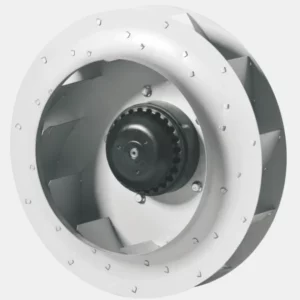Centrifugal fans are widely utilized in various industries and applications to generate high-pressure airflow. Among the different types of centrifugal fans, the backward curved design stands out for its efficiency, low noise, and versatility. In this article, we will delve into the working principles of backward curved centrifugal fans, exploring their key components, airflow generation, and advantages.
The Anatomy of a Backward Curved Centrifugal Fan
- Impeller:
The impeller is the primary component responsible for generating airflow in a backward curved centrifugal fan. It consists of a series of blades that curve backward against the direction of rotation. The backward curve impeller design allows for efficient air movement and pressure generation. - Housing or Casing:
The impeller is housed within a casing or housing that directs and controls the airflow. The housing is designed to gradually expand in diameter from the impeller’s inlet to the outlet, providing a smooth path for the airflow. This expansion helps convert the kinetic energy of the air into pressure energy.
Airflow Generation
- Inlet Stage:
As the fan starts rotating, ambient air enters the fan through the inlet. The inlet stage of the backward curved centrifugal fan is designed to have a gradual entry to minimize turbulence and pressure losses. The curved shape of the blades aids in drawing air into the fan, creating a low-pressure region near the impeller’s inlet. - Air Acceleration:
As the impeller blades rotate, their backward curve accelerates the incoming air radially outward. The curved shape and angle of the blades impart a tangential velocity component to the air, causing it to move in a circular path. This acceleration converts kinetic energy into potential energy, increasing the pressure of the air. - Pressure Rise:
The high-speed air exiting the impeller enters the expanding housing or casing. The expanding cross-sectional area of the casing allows the air to decelerate gradually, resulting in a pressure rise. The backward curved blades efficiently convert the kinetic energy of the air into pressure energy, creating a high-pressure region at the fan’s outlet. - Air Discharge:
The high-pressure air is discharged from the fan through the outlet. The discharged air can be directed to the desired location, such as a duct or a system that requires pressurized airflow. The backward curved design ensures that the airflow is evenly distributed and minimizes turbulence and noise generation.
Advantages of Backward Curved Centrifugal Fans
- High Efficiency:
Backward curved centrifugal fans are known for their high efficiency due to the aerodynamic design of the impeller. The curved blades optimize airflow movement, minimize losses, and convert kinetic energy into pressure energy more effectively, resulting in improved efficiency and energy savings. - Low Noise Levels:
The backward curved design helps reduce noise emissions compared to other fan types. The gradual acceleration and deceleration of the air within the fan, along with the efficient airflow distribution, contribute to lower noise levels. This makes backward curved centrifugal fans suitable for applications where noise reduction is essential. - Wide Operating Range:
Backward curved centrifugal fans offer a broad operating range, allowing them to handle varying airflow demands. They can maintain relatively high efficiency even at reduced flow rates, making them suitable for applications where airflow requirements change dynamically. - Versatility:
Backward curved centrifugal fans find applications in a wide range of industries. They are commonly used in heating, ventilation, and air conditioning (HVAC) systems, industrial processes, cleanrooms, and other ventilation applications that require high-pressure airflow.
Can you explain how the backward curved design helps in reducing noise emissions?
The backward curved design of centrifugal fans contributes to the reduction of noise emissions through several key factors:
- Aerodynamic Efficiency: The backward curved impeller blades are carefully designed to optimize the airflow path and improve aerodynamic efficiency. This design allows for smoother air movement with reduced turbulence. By minimizing turbulence, the generation of noise-causing vortices and eddies is significantly reduced.
- Gradual Airflow Acceleration and Deceleration: The backward curved blades facilitate a gradual acceleration of the incoming air as it moves from the impeller’s inlet to the outlet. This gradual acceleration minimizes abrupt changes in airflow velocity, which can contribute to noise generation. Similarly, when the air exits the impeller and enters the expanding housing or casing, it decelerates gradually. This controlled deceleration helps reduce noise associated with sudden changes in airflow speed.
- Reduced Pressure Pulsations: The backward curved design helps to minimize pressure pulsations within the fan. Pressure pulsations, caused by sudden changes in pressure, can generate noise. The gradual acceleration and deceleration of the airflow in a backward curved centrifugal fan reduce pressure fluctuations, resulting in a smoother and quieter operation.
- Even Airflow Distribution: The backward curved impeller blades are designed to distribute the airflow more evenly across the fan’s outlet. This uniform distribution helps to avoid localized areas of turbulence and pressure imbalances, which can contribute to noise generation. By promoting a balanced airflow, the backward curved design helps to mitigate noise-causing effects.
- Lower Blade Tip Speed: Backward curved centrifugal fans typically operate at lower blade tip speeds compared to other fan designs. The lower tip speeds contribute to reduced noise levels, as high tip speeds are often associated with increased aerodynamic noise. The backward curved design allows for effective airflow generation at lower speeds, thereby minimizing noise emissions.
Backward curved centrifugal fans offer efficient and reliable airflow generation in various industrial and commercial applications. Through their unique impeller design and housing configuration, these fans achieve high efficiency, backward curved centrifugal fan manufacturers low noise levels, and a wide operating range. Understanding the principles and advantages of backward curved centrifugal fans is crucial for selecting the appropriate fan type to meet specific airflow requirements while optimizing energy consumption and maintaining a comfortable and productive environment.
